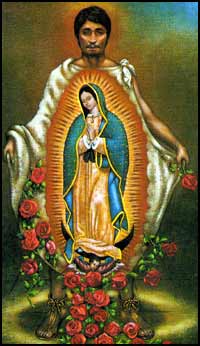

ping
bump
Beautiful story. Thanks.
P.S. At the rate Aztecs were killing themselves it is a wonder they didn't die out.
Why Juan Diego is an American Saint
Blessed Juan Diego: A Model of Humility



|
|
 |
December 9, 2006
St. Juan Diego
(1474-1548)
Thousands of people gathered in the Basilica of Our Lady of Guadalupe July 31, 2002, for the canonization of Juan Diego, to whom the Blessed Mother appeared in the 16th century. Pope John Paul II celebrated the ceremony at which the poor Indian peasant became the Church’s first saint indigenous to the Americas.
The Holy Father called the new saint “a simple, humble Indian” who accepted Christianity without giving up his identity as an Indian. “In praising the Indian Juan Diego, I want to express to all of you the closeness of the church and the pope, embracing you with love and encouraging you to overcome with hope the difficult times you are going through,” John Paul said. Among the thousands present for the event were members of Mexico’s 64 indigenous groups. First called Cuauhtlatohuac (“The eagle who speaks”), Juan Diego’s name is forever linked with Our Lady of Guadalupe because it was to him that she first appeared at Tepeyac hill on December 9, 1531. The most famous part of his story is told in connection with the Feast of Our Lady of Guadalupe (December 12). After the roses gathered in his tilma were transformed into the miraculous image of Our Lady of Guadalupe, however, little more is said about Juan Diego. In time he lived near the shrine constructed at Tepeyac, revered as a holy, unselfish and compassionate catechist who taught by word and especially by example. During his 1990 pastoral visit to Mexico, Pope John Paul II confirmed the long-standing liturgical cult in honor of Juan Diego, beatifying him. Twelve years later he was proclaimed a saint. Quote:
|
||||||
|
|
Saint Juan Diego, Hermit
Optional Memorial
December 9th

unknown artist
St Juan Diego Cuauhtlatoatzin (1474-1548). Little is known about the life of Juan Diego before his conversion, but tradition and archaelogical and iconographical sources, along with the most important and oldest indigenous document on the event of Guadalupe, "El Nican Mopohua" (written in Náhuatl with Latin characters, 1556, by the Indigenous writer Antonio Valeriano), give some information on the life of the saint and the apparitions.
Juan Diego was born in 1474 with the name "Cuauhtlatoatzin" ("the talking eagle") in Cuautlitlán, today part of Mexico City, Mexico. He was a gifted member of the Chichimeca people, one of the more culturally advanced groups living in the Anáhuac Valley.
When he was 50 years old he was baptized by a Franciscan priest, Fr Peter da Gand, one of the first Franciscan missionaries. On December 9, 1531, when Juan Diego was on his way to morning Mass, the Blessed Mother appeared to him on Tepeyac Hill, the outskirts of what is now Mexico City. She asked him to go to the Bishop and to request in her name that a shrine be built at Tepeyac, where she promised to pour out her grace upon those who invoked her. The Bishop, who did not believe Juan Diego, asked for a sign to prove that the apparition was true. On 12 December, Juan Diego returned to Tepeyac. Here, the Blessed Mother told him to climb the hill and to pick the flowers that he would find in bloom. He obeyed, and although it was winter time, he found roses flowering. He gathered the flowers and took them to Our Lady who carefully placed them in his mantle and told him to take them to the Bishop as "proof". When he opened his mantle, the flowers fell on the ground and there remained impressed, in place of the flowers, an image of the Blessed Mother, the apparition at Tepeyac.
With the Bishop's permission, Juan Diego lived the rest of his life as a hermit in a small hut near the chapel where the miraculous image was placed for veneration. Here he cared for the church and the first pilgrims who came to pray to the Mother of Jesus.
Much deeper than the "exterior grace" of having been "chosen" as Our Lady's "messenger", Juan Diego received the grace of interior enlightenment and from that moment, he began a life dedicated to prayer and the practice of virtue and boundless love of God and neighbour. He died in 1548 and was buried in the first chapel dedicated to the Virgin of Guadalupe. He was beatified on May 6, 1990 by Pope John Paul II in the Basilica of Santa Maria di Guadalupe, Mexico City.
The miraculous image, which is preserved in the Basilica of Our Lady of Guadalupe, shows a woman with native features and dress. She is supported by an angel whose wings are reminiscent of one of the major gods of the traditional religion of that area. The moon is beneath her feet and her blue mantle is covered with gold stars. The black girdle about her waist signifies that she is pregnant. Thus, the image graphically depicts the fact that Christ is to be "born" again among the peoples of the New World, and is a message as relevant to the "New World" today as it was during the lifetime of Juan Diego.
http://www.vatican.va/news_services/liturgy/saints/ns_lit_doc_20020731_juan-diego_en.html
Collect:
Lord God,
through Saint Juan Diego
You made known the love of Our Lady of Guadalupe
toward Your people.
Grant by his intercession
that we who follow the counsel of Mary, our Mother,
may strive continually to do Your will.
We ask this through our Lord Jesus Christ, Your Son,
who lives and reigns with You and the Holy Spirit. Amen.
Readings from the Common of Holy Men and Women